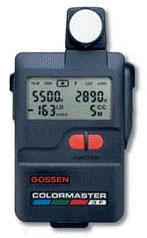 A colour temperature meter is a device for measuring the precise colour temperature of the light in a particular environment. It can be used in conjunction with appropriate colour correction filters or white balance to correct the colours recorded in an image so that they match human perception.
A colour temperature meter is a device for measuring the precise colour temperature of the light in a particular environment. It can be used in conjunction with appropriate colour correction filters or white balance to correct the colours recorded in an image so that they match human perception.
When taking photographs with non-standard lights, or a combination of artificial lights and daylight, it should be remembered that the resulting colour temperature is unknown. Under such circumstances it is worth measuring the colour temperature of the light source with a colour temperature meter. Any mismatch between the colour temperature for which film is balanced and the light source can then be corrected by using colour correction filters fitted over either the light sources or the camera lens. In the case of a digital camera, it may be possible to adjust the white balance directly. For example, a blue 80B colour correction filter can be used to cool the reddish colour of a tungsten light from 3,200°K to the 6,500°K of standard daylight.
The skill needed to achieve reliable results when using non-standard lighting probably makes this a task for professional photographers. A colour temperature meter is a relatively expensive piece of equipment, and it may be cheaper to use simpler standardized lighting equipment to avoid the problem altogether.






